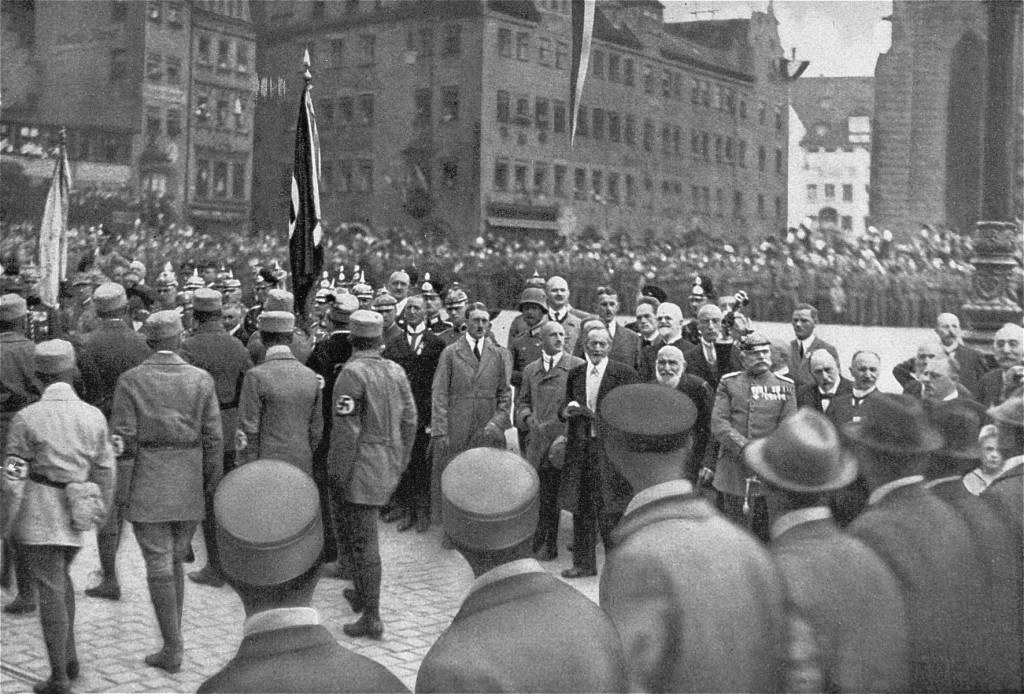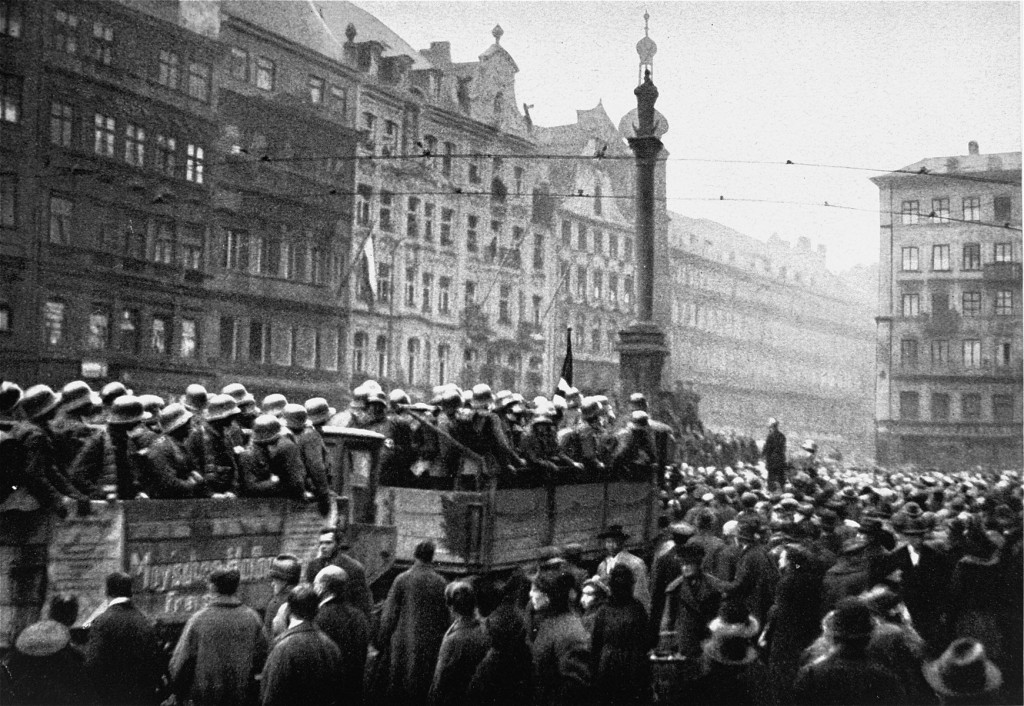
Adolf Hitler: 1919-1924
After World War I
In October 1918, toward the end of World War I, Hitler was partially blinded in a mustard gas attack near Ypres in Belgium. He was sent to the military hospital in Pasewalk and was there at the time of the armistice on November 11, 1918. Hitler returned to Munich on November 21, 1918, two days after his release from the hospital in Pasewalk, Pomerania. He was at that point a Private First Class in the 7th Company, 1st Reserve Battalion of the 2nd Regiment in the German Army.
During the next six months Hitler had an opportunistic association as soldiers’ council representative to the civilian authorities in Bavaria with the Independent Socialist-led coalition Bavarian state government of Kurt Eisner, which assumed power in November 1918. After Eisner’s assassination by the right-wing fanatic Count Anton von Arco-Valley in February 1919, he had a similarly opportunistic association with the Bavarian Soviet Councils Republic. He played no part in the overthrow of the Councils Republic on May 2 by Freikorps units, or in the establishment of the military administration that governed Bavaria until a civilian government could be formed.
Recruited to the Information Office of the Military Administration
At the end of May 1919, Hitler was recruited to work for the information office of the military administration commanded by Captain Karl Mayr. Among its tasks were gathering intelligence on political movements potentially hostile to the Bavarian authorities and tending to the “political education” of the troops to counter alleged Bolshevik (Communist) influences.
Hitler excelled in a training course in early June, and in August 1919 became an instructor for a five-day course for Reichswehr (German Armed Forces) personnel at a base in Lechfeld near Augsburg. Hitler stood out as an effective communicator, and made his first virulent antisemitic speeches in Lechfeld.
First Statement on the “Jewish Question”
Impressed with Hitler’s skills as a communicator, Mayr entrusted him with responding to a Reichswehr client request for elaboration on the so-called Jewish question. In a letter of September 16, 1919, Hitler first identified Jews as a so-called race that served as the “driving force” of Communist revolution in Bavaria. He characterized Jews collectively as the “tuberculosis of the peoples,” calling for a nationalist government to remove them completely from Germany.
Rise to Leadership in the German Labor Party
Related to his intelligence gathering function, Hitler and two colleagues attended a September 12, 1919, meeting of the German Labor Party (Deutsche Arbeiterpartei--DAP), a völkisch (race-based)-nationalist organization. During the meeting, Hitler denounced a speech favoring Bavarian separatism. Within a month, Hitler had joined the DAP with the number 555. His discharge from the army came through on March 31, 1920.
Due to his speaking abilities, charisma, and tireless energy, Hitler quickly rose into the DAP leadership ranks. He contributed significantly to the development and announcement of a DAP Program on February 20, 1920, at the Munich Hofbräuhaus. Among other aims, the program advocated:
- national unity based on so-called racial criteria
- expansion of the nation’s territory
- revocation of the Treaty of Versailles
- exclusion of Jews from citizenship and all occupations and professions requiring citizenship
- halting non-German immigration
A few weeks later, in early March, the DAP changed its name to National Socialist German Workers’ Party (Nationalsozialistische Deutsche Arbeiterpartei—NSDAP).
Leader of the Nazi Party
Combining his considerable oratory capabilities with an unusual ability to read audience mood, both in individuals and large groups, Hitler established himself as absolute Führer (Leader) of the NSDAP by 1921.
Using contacts made with former military circles, especially with the well-known former air force ace Hermann Göring and former Army Captain Ernst Röhm, Hitler grew the party to a membership of 55,000 by November 1923. In 1921, Röhm established a closely affiliated paramilitary force known as the Assault Detachments (Sturmabteilungen—SA). More commonly known in English as “storm troopers,” the SA units numbered 4,000-5,000 men by the spring of 1923. Several conditions facilitated the dramatic growth of the party, including:
- violent political confrontation between paramilitary formations and political movements on both the right and the left
- outrage in Germany at the Franco-Belgian occupation of the Ruhr in January 1923
- the emerging inflationary crisis of 1923
Hitler, the Nazi Party leadership, and the SA rejected political participation in Weimar elections. They formed an uneasy alliance with leaders of the conservative quasi-dictatorial Bavarian government under Gustav Ritter von Kahr, the Commander of the 7th Reichswehr Division stationed in Munich, General Otto Hermann von Lossow, and Bavarian State Police Chief Colonel Hans Ritter von Seißer. Each partner, though hostile to and favoring the overthrow of the central government in Berlin, had a radically different agenda.
The Nazis pursued the establishment of an authoritarian, nationalist central government, while Bavarian officials hoped to consolidate an equally authoritarian, but more independent regime in Bavaria, which would increase its political distance from Berlin.
Beer Hall Putsch

Using as justification chaos created by the occupation of the Ruhr, the inflationary spiral, and Communist agitation in central Germany, Hitler pushed his reluctant conservative partners into agreeing to a march on Berlin to overthrow the Weimar Republic. The planners of the overthrow had crashed a rally organized by von Kahr and held the Bavarian leaders hostage through the night of November 8-9, 1923, while they debated how to proceed.
At noon on November 9, Hitler, Göring, and other Nazi leaders, accompanied by former Field Marshall Erich von Ludendorff, marched at the head of 2,000 Nazis and other right-wing activists and paramilitaries west and north from the Bürgerbräukeller on the Rosenstrasse onto the Ludwigsstrasse towards the headquarters of the commander of troops stationed in Bavaria. This was ostensibly the first step in the so-called Beer Hall Putsch. Though promising to support the putsch, von Kahr, von Lossow, and von Seißer reneged immediately after the putschists released them, calling out the police to suppress the putsch. As they marched up the Ludwigsstrasse towards the Odeonsplatz, Hitler and his followers confronted an armed police detachment. Following a few shots, the police opened fire, a volley that effectively suppressed the Beer Hall Putsch.
Arrest and Imprisonment
After the failed putsch, German authorities banned the Nazi Party and its formations and arrested many of the ringleaders, including Hitler, Ludendorff, Röhm, and future Nazi Interior Minister Wilhelm Frick, on charges of high treason. The trial, held in Munich between February 27 and March 24, 1924, enabled Hitler to act the patriotic nationalist, who, honorably motivated, merely defended the German nation against the so-called November criminals and the authorities of the Weimar Republic, whose spineless subservience to the Western Powers and inability to counter the Bolshevik threat represented the “real” high treason against the German people. He also hinted at exposing the initial complicity of the Bavarian government, military and police in planning a putsch.
Both argument and delivery elicited sympathy from the tribunal judges and dramatically increased Hitler’s name recognition across the country. Though convicting him of high treason, the Munich court handed down the lowest possible sentence: five years, of which Hitler served nine months in relative comfort at Landsberg prison, where he dictated the first volume of his infamous autobiography, Mein Kampf (My Struggle), published in autumn 1925.
After his release from prison, he wrote the second volume of Mein Kampf, which appeared in December 1926. With this publication, Hitler unveiled an explicitly, race-based nationalist, social Darwinist, and antisemitic vision of human history, informing an imperative to secure Germany’s survival and greatness in the future through military conquest and seizure of “living space” (Lebensraum) in the East, on the territory of a conquered Soviet Union, which would be cleansed through annihilation and/or decimation of indigenous populations.
Critical Thinking Questions
The Nazi regime required the active help or cooperation of professionals working in diverse fields who in many instances were not convinced Nazis. How did Hitler and other Nazi leaders use their positions of power to put their radical ideas into practice?
What other societal factors and attitudes contributed to the rise of Hitler?
How can knowledge of the events in Germany and Europe before the Nazis came to power help citizens today respond to threats of genocide and mass atrocity?

